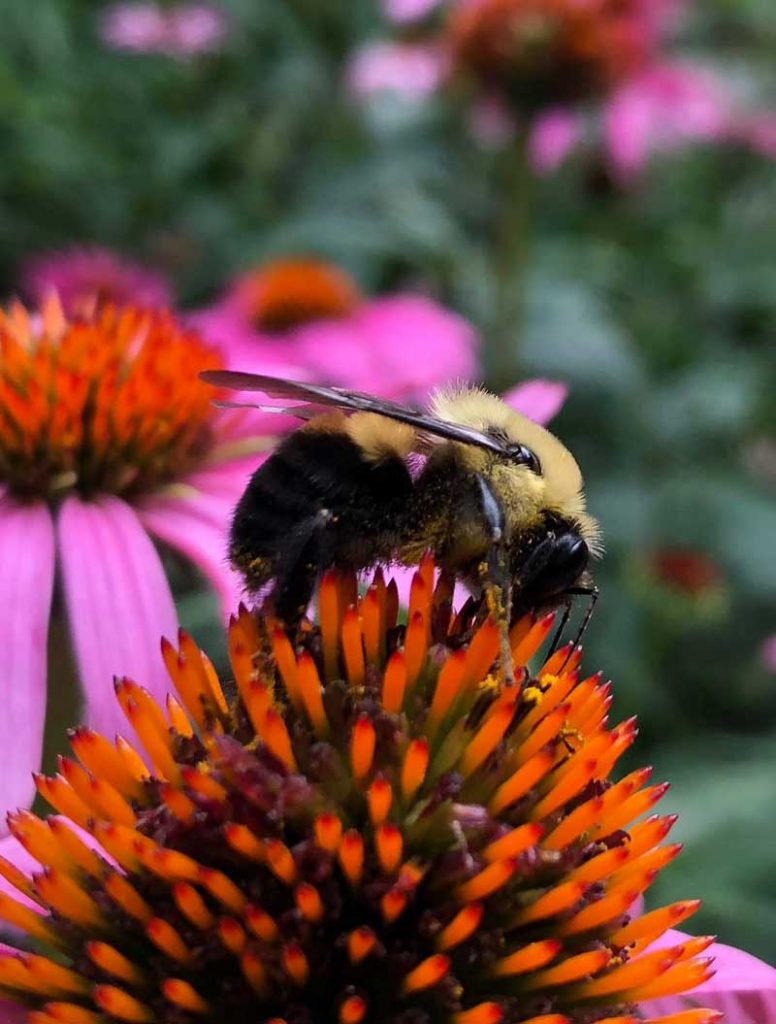It’s not uncommon to see your garden infested with insects and have the urge to get rid of them. But as Mark Konlock (Director of Horticulture) says, sometimes you have to learn to live with the damage of insects because it likely means you’re supporting a healthy ecosystem full of plants, trees, insects, and other wildlife! Take a moment to consider how many of these insects are actually helping your garden and plants flourish.
When it comes to dealing with insects, it’s not always about getting all of the insects out of your garden, it’s about getting the right insects into your garden! Follow along and learn some tips and tricks to maintaining a space that welcomes beneficial insects.
PAUSE THE PESTICIDES
Pesticides will get rid of the insects that bother your plants, but they aren’t selective. They’ll also eliminate helpful insects who call your garden, backyard, or porch home.
Instead of wiping out your entire insect population and potentially causing even more harm to your garden and the environment, consider building an insect hotel for the welcomed insects. Let them take care of your plants and the insects you don’t want!

WHO’S ON THE GUEST LIST
When making your insect hotel, it’s important to consider what types of insects you’re hoping to attract or already have in your garden. Each type of insect will have different preferences and needs you can tailor your hotel to.
BEES PLEASE
If you think bees will be the primary occupant of your insect hotel, you’ll want to have plenty of hollow tubes and holes of varying sizes. To achieve this, you can use the stems of hollow plants, cardboard or paper straws/tubes, or a block of wood with holes drilled into it.

OUT WITH THE APHIDS
If your garden has an aphid problem, you’ll want to make your outdoor living space especially welcoming to ladybugs who eat aphids. Consider including lots of dry leaves, sticks, and/or straw to build a ladybug hotel. Lacewings also eat aphids and can thrive in an insect hotel with lots of corrugated cardboard.
CARE FOR THE CRAWLERS
Your garden may also be home to some “creepy” crawlers like beetles, centipedes, or spiders – which is technically an arachnid. While it might be tempting to get rid of these types of multi-legged invertebrates, they’re beneficial to your garden too!
These bugs feed on unwanted pests so consider welcoming them with a hotel built from dead wood and dry bark.
HOTEL SIZE & STRUCTURE
Your insect hotel can be as big and elaborate or small and simple as you want it to be. Try mixing and matching different materials to make your insect hotel appealing to any number of insects or build it with just one species in mind.
No matter the materials you use or the insect who occupies your hotel, it’s important to construct a roof and walls. This will shelter your hotel inhabitants from the rain.

HOTEL LOCATION
Some insects, like bees, prefer to be in the sun while others like to spend their time in the shade. It’s important to place your insect hotel where it will meet the needs of your intended insect guests. If you’re hoping to cater to a variety of insects, build the hotel somewhere with a nice mix of sun and shade.
Check out these guides for more on how to build hotels for insects and bees in your outdoor living spaces and keep an eye out for beneficial insects during your next trip to the Garden!





